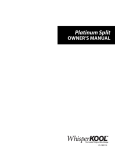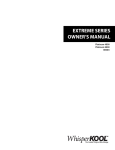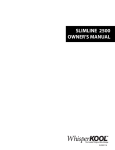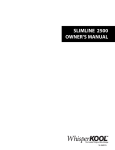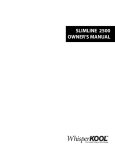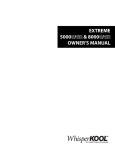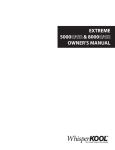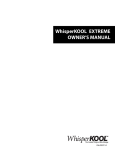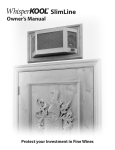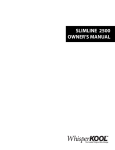Download WhisperKool InCellar 8000 Low Speed Owner`s manual
Transcript
SPLIT SYSTEM OWNER’S MANUAL TO BE USED WITH YOUR SYSTEM’S UNIT SPECIFIC INSTALLATION GUIDE The Coolest Thing In Wine Storage Copyright © 2010. WhisperKOOL. All rights reserved. This manual, the product design, and the design concepts are copyrighted by WhisperKOOL, with all rights reserved. Your rights with regard to the hardware and manual are subject to the restrictions and limitations imposed by the copyright laws of the United States of America. Under copyright laws, this manual may not be copied, reproduced, translated, transmitted, or reduced to any printed or electronic medium or to any machine-readable form, for any purpose, in whole or in part, without the written consent of WhisperKOOL. Every effort has been made to ensure that the information in this manual is accurate. WhisperKOOL is not responsible for printing or clerical errors. WhisperKOOL reserves the right to make corrections or improvements to the information provided and to the related hardware at any time, without notice. Vinothèque and WhisperKOOL are registered trademarks, and ECE is a trademark of Vinothèque Wine Cellars. All rights reserved. Mention of third-party products is for informational purposes only and constitutes neither an endorsement nor a recommendation. WhisperKOOL assumes no liability with regard to the performance or use of these products. Rev. 081310 Page 2 GSM-01 081310 TABLE OF CONTENTS Introduction ............................................................................................................. 2 Receiving & Inspecting The Unit................................................................................. 3 Preparing the Wine Cellar ......................................................................................47 Installation ...................................................................................................................6 7 Remote Keypad ............................................................................................................... 9 Ducted Installation ................................................................................................ 10 Liquid Measuring Thermometer ............................................................................... 11 System Operation ......................................................................................................12 Control Panel Operation ............................................................................................... 13 Maintenance Schedule ................................................................................................. 16 Troubleshooting Guide ................................................................................................. 17 Wiring Diagrams ............................................................................................................. 22 Technical Assistance ......................................................................................................... 26 Installation Terms and Conditions ............................................................................. 27 Page 1 INTRODUCTION Customer Service Thank you for purchasing a WhisperKOOL split system. We strive to provide the highest quality products and the best possible customer service. If you have any questions about your WhisperKOOL unit, please call us at 1(800) 343-9463 or visit www.whisperkool.com. Using this Manual This Owner’s Manual is intended to be a general WhisperKOOL split system installation and maintenance guide. Please use the supplied unit specific installation guide in conjunction with this manual. In order to ensure the longevity of your cooling system, the equipment should be installed properly and have a proper care and maintenance schedule. Please read and review this manual carefully and keep it for future reference. What is a WhisperKOOL Split System? Specialized refrigeration systems designed for one purpose only: to maintain the optimal temperature and humidity levels conducive to the proper storage and aging of fine wines. Split systems produce minimal in-cellar noise and have the most lenient exhaust requirements. An exterior housing is required for outdoor condensing unit installations. How Does a WhisperKOOL Split System Work? Similar to the air conditioning systems used for homes, the evaporator and condensing units are installed in separate locations and are connected by a line set. The evaporator portion is commonly installed in the wine cellar, with the condensing unit located either outside or in a remote indoor location. Page 2 GSM-01 081310 RECEIVING & INSPECTING THE UNIT Customer Warranty Registration PLEASE COMPLETE AND RETURN THE WARRANTY CARD UPON RECEIPT OF THE UNIT. By completing the Product Registration Card, you will be confirmed in our customer database ensuring that your information is on file to help you obtain efficient warranty service. Please refer to page 25 for complete terms and conditions, warranty guidelines, and policy for your WhisperKOOL split system. Note: WhisperKOOL split systems are manufactured in the USA and tested prior to shipment. Receiving and Inspecting the System • Lift only at the designated hand hold locations on the shipping container or fully support the unit from underneath. A shipment may include one or more boxes containing accessories. • Before opening the container, inspect the packaging for any obvious signs of damage or mishandling. • Record any discrepancy or visual damage on the Bill of Lading before signing. Review the Packing Slip to Verify Contents • Check the model number to ensure it is correct. • Check that all factory options ordered are listed. If any items listed on the packing slip do not match your order information, contact WhisperKOOL Customer Service immediately at 1-800-343-9463. Check your shipment for the following contents: • Evaporator Unit • Condensing Unit • Unit Specific Installation Guide • Registration / Warranty Card • Sight Glass • Filter Drier • Accessory Kit • Mounting Hardware Note: Refer to the Unit Specific Installation Guide (USIG) for a detailed packing list for your specific split system order. Please leave the WhisperKOOL system in its original boxes until you are ready for installation. This will allow you to move the product safely without damaging it. WhisperKOOL highly recommends that you save your boxes and all packaging materials. They provide the only safe means of transporting/shipping the system. When you are ready to remove the product from the boxes, refer to page 6 for installation instructions. Page 3 PREPARING THE WINE CELLAR The performance and life of your WhisperKOOL system are contingent upon the steps you take in preparing the wine cellar. Note: Improperly preparing your enclosure or incorrectly installing your WhisperKOOL system may cause unit failure, leaking of condensation, and other negative side effects. IT IS HIGHLY RECOMMENDED THAT YOU OBTAIN THE ASSISTANCE OF A WINE STORAGE PROFESSIONAL. Wine storage professionals work with licensed contractors, refrigeration technicians, and racking companies to build well-insulated, beautiful, and protective wine cellars. WhisperKOOL has put together some useful tips to assist in the installation process. Our recommendations are meant to act as a guide in the process of building a proper enclosure. Your intended location may have specific needs that we do not address. Wall & Ceiling Framing Build wine cellar walls using standard 2x4 or 2x6 construction methods and ceiling joists following the guidelines of local and state codes in your area. As a general rule, the thicker the walls and the higher the insulation factor in your cellar, the better it will be at maintaining a consistent temperature. Insulation Insulation is REQUIRED with the use of the WhisperKOOL product. Standard fiberglass or rigid foam insulation is normally used in cellar construction or, in some cases, “blown-in” insulation is used. It is very important that all walls and ceilings are insulated to keep the cellar temperature as consistent as possible during the summer and winter months. The R-factor, or quality of insulation, is determined by the rate at which heat passes through the insulation. The higher the R-factor, the more resistant the insulation is to conducting heat. Using higher R-values in insulation will lower your operating costs and unit run time. Vapor Barrier Vapor barrier is REQUIRED to prevent the intrusion of water vapor so that the cellar can be kept at the correct temperature and humidity. 6 mm plastic sheeting (recommended) should be applied to the warm side of the cellar walls. The vapor barrier must also be applied to the outside walls and ceiling. If it is impossible to reach the outside, then the plastic must be applied from within the cellar. The most common method is to wrap the entire interior, leaving the plastic loose in the stud cavity so the insulation can be placed between each stud. All of the walls and ceiling must be wrapped in plastic for a complete vapor barrier. In areas of high humidity, such as Southern and Gulf States, the vapor barrier will prevent infiltration of warm moist air. The moist air can cause mold to form, and standing water in drain pans promote microbial and fungal growth that cause unpleasant odors and indoor air quality problems. If mold is found, remove it immediately and sanitize that portion of the system. Door and Door Seal An exterior grade (1 3/4”) door must be installed as a cellar door. It is very important that weather stripping is attached to all 4 sides of the doorjamb. A bottom “sweep” or threshold is also required. The door must have a very good seal to keep the cool cellar air from escaping out of the cellar. One of the most common problems with cooling units running continually is the door not sealing properly. In cases where glass doors are used and the room size is close to the recommended unit size, the next larger size WhisperKOOL should be used. This will compensate for the insulation loss due to the inefficient door. Page 4 GSM-01 081310 Unobstructed Airflow Unobstructed airflow to and from both the evaporator and condenser is a critical factor in the system’s overall performance. Make sure there is a 3 ft. horizontal clearance in the front of both units. This will assure that the air can circulate in an efficient manner. Avoid any attempt to camouflage the evaporator by installing racking in front of the unit. This will restrict the airflow and reduce system performance. In-Cellar Mounting If you are mounting your evaporator in the cellar, it should be mounted within 18“ of the top of the room in order to achieve sufficient cooling. As the room cools down, the warm air will rise to the ceiling. Mounting the evaporator high in the room will create a consistently cool environment by capturing the warm air and replacing it with cool air. Mounting the evaporator low in the room will result in a temperature variation in the room due to the unit’s inability to draw warm air from the ceiling of the cellar to the unit itself. Ducting Some systems are designed to have the air exchange happen out of the cellar using duct work. This allows the evaporator unit to placed in a variety of positions around the cellar and in some models up to 25 duct feet away. The return air (from cellar to unit) needs to be located low in the cellar with the supply air (from unit to cellar) should be located high in the cellar. This greatly increases the efficiency of the cooling system by allowing the cold air travel throughout the entire cellar space and absorb as much heat as possible. How to Build a Wine Cellar Instructional Video WhisperKOOL has a construction tutorial available on line at www.whisperkool.com, or you can call 1-800343-9463 and contact our Customer Service (ext. 799) or Sales Department (ext. 751) for information on how to obtain a DVD version. This tutorial will walk you through the steps of constructing a properly built wine cellar and the installation of our WhisperKOOL product line. Page 5 SPLIT SYSTEM INSTALLATION General Installation Guidelines and Instructions WhisperKOOL requires that a certified HVAC technician install and charge all split systems. Please take a moment to review state and city building codes to ensure the safe and proper installation of the system. Electrical Needs WhisperKOOL split systems requires a dedicated 110-volt 20-amp circuit. The system draws a large amount of amps at initial start up. By designating a dedicated circuit breaker, you will guarantee that the system has enough power to run effectively. Contact an electrician for assistance with the installation of this dedicated electrical circuit: 1. Match the electrical outlet to the plug provided on the WhisperKOOL unit. 2. Provide a dedicated circuit and wiring for the unit. 3. Provide a weatherproof plug for units mounted outside. WE RECOMMEND THAT YOU DO NOT USE A GROUND FAULT INTERRUPTER (GFI) WITH THIS PRODUCT. In case the system should lose power, press the reset button and attempt to turn the unit back on. Check the home/main circuit breaker. If the unit does not respond properly, refer to the Troubleshooting section on page 17. Condensing Unit Preparation Note: The condensing unit is shipped with a protective foam pad/ block to prevent damaging tubing against the condenser coil fins. Please ensure that this pad is removed prior to operation. *A Low Ambient Control is used on most models, a Fan Cycling Switch is used otherwise. Page 6 GSM-01 081310 Installing the Condensing Unit The condensing unit can be mounted inside a utility area of the home or outside utilizing the required outdoor condensing unit housing. The condenser requires a dedicated 20 amp circuit, non-GFI. Make sure there is a minimum three-foot horizontal clearance in front and rear of the unit. The unit may either be hard wired or plug-in depending on local electrical codes. Inside Condensing Unit Installations: Inside installations require special consideration, as there must be adequate ventilation to dissipate the heat created during normal operations. An exhaust port with fan may need to be installed to ensure that heat is effectively removed from the utility room. A return grille or provision for 500 - 600 cfm of cool air to enter the room to replace the exhausted air will accomplish this. Unobstructed airflow to and from the unit is a critical factor in the unit’s overall performance. Make sure there is a minimum three-foot horizontal clearance in front and rear of the unit. This will assure that the unit can move the air around the room in an efficient manner. Outdoor Condensing Unit Installations. You must utilize the exterior condensing unit housing for outdoor installations. Place the condensing unit on a solid foundation in a location with adequate ventilation. There should be three feet of clearance in the front and rear of the unit and one foot on each side. The unit should be elevated 18 inches in order to avoid any possible flooding or damage by animals, and should be clear of leaves, dirt, and other debris. Page 7 SPLIT SYSTEM INSTALLATION (cont’d) Installing the Evaporator Unit Please refer to the supplied Unit Specific Installation Guide for detailed evaporator installation guidelines. Head Pressure Control, Low Ambient Control Switch, Fan Cycling Switch: These switches are used to cycle the condenser fan at low ambient temperature conditions. If your unit is equipped with a Low Ambient Control, set the switch to 170 psig for cut-in and 70 psig for the differential. Further adjustment may be needed. Verify the settings via refrigeration manifold gauge and perform the final adjustments to the readings on the gauge manifold. If your condensing unit is not equipped with a Low Ambient Control, it features a pre-set Fan Cycling Switch. Refrigeration Lines A 1/4 inch O/D copper “liquid line” and a 3/8 or 1/2 inch O/D copper “suction line” connect the two units. The refrigerant drier and the sight glass shall be installed (in that order) in the direction of the refrigerant flow in the liquid line between the condensing unit and evaporator. Enclose the suction line in a cellular insulation ½” wall thickness Armaflex (brand name) or equal to reduce heat transfer. Wiring System The compressor is controlled by a “pump down cycle,” therefore, no wiring between the condensing unit and evaporator unit is necessary. Wire the system in accordance with local codes and the enclosed wiring diagrams (pg 22). The evaporator unit requires a standard 20 amp circuit, non-GFI. A dedicated circuit is not mandatory, but recommended. Charging the System (by Certified HVAC technician) After all the piping is complete: Open both of the service valves on the condensing unit (the unit is pressurized with nitrogen, and there should be an audible sound of gas escaping through the service ports). With electrical power connected to the evaporator unit, energize the solenoid valve (pressurize with dry nitrogen) to 200psi. Leak test all fittings. The system must hold 200psi for 30 minutes. If no leaks are found, leave the solenoid valve energized and evacuate the system through both the liquid and suction service ports. Using a high vacuum pump, evacuate to 200 microns, measuring the vacuum with a digital micron gauge. When evacuation is complete, break vacuum and pressurize with liquid R-134A refrigerant. With the electrical power turned on to the condensing unit, and the evaporator unit running, slowly feed liquid refrigerant (R134A) into the suction service port. As the suction pressure rises to 15 PSIG, the condensing unit will start. Slowly feed refrigerant while maintaining a pressure above 10 PSIG to prevent the compressor from short cycling. Slowly feed refrigerant with the compressor running until the sight glass is clear of all bubbles. Do not exceed 3.5 lbs of refrigerant. Check superheat at the evaporator outlet. Superheat should be at 10°-12°. Check the compressor crankcase temperature after 30 minute run time – it should be hot (115°to 140°). If it is cooler, superheat is too low. Adjust TXV to recommended superheat. Allow the system to operate for one hour and then check the refrigerant level in the sight glass again. Additional refrigerant may be required as the temperature of the enclosure is lowered to approximately 55°F or the ambient temperature at the condensing unit rises above the temperature at which the unit was initially charged. Depending on temperature, the “high side” should be approximately 175 lbs, and the ”low side” 28 lbs or more to keep the evaporator from icing. It is recommended while charging to use a digital refrigerant scale for better accuracy in measuring the amount of charge. Page 8 GSM-01 081310 REMOTE KEYPAD: INSTALLATION AND CONFIGURATION If you have a system with a remote keypad, please review this section for installation. Note: 50 feet of communication line is included, the keypad can be installed up to 300 line feet away. Longer lengths of communication line can be ordered by calling 1-800-343-9463 ext. 751. Run your communication line to the desired location, be sure not to have any harsh kinks in the lines route. Attach the connection wire as shown below, with the red wire in the upper connection slot and the black wire in the lower slot. It is also important to run your bottle probe line at this time, Red Wire Black Wire To install the remote keypad box, remove the rear mounting bracket and secure the bracket to the wall in the desired location. When running the communication line through a wall, be sure to run the line in the rear mount position and insert the supplied plug in the side hole on the box. Reattach the keypad box to the bracket. TM TM TM TM Connection wire in Side Mount configuration Connection wire in Rear Mount configuration Page 9 DUCTED INSTALLATION Ducting the supply and return air to the cellar creates a virtually silent cellar space and also maximizes cellar capacity. It is absolutely crucial to only use insulated duct work as it minimizes cooling loss, prevents sweating, and reduces noise. Failure to use insulated ducting will cause the unit to run excessively and greatly shorten its lifespan. Note: Do not exceed a total of 25 duct feet between the evaporator and cellar vent, this means a total of 50’ combined for both the supply and return lengths. Avoid crimping the flexible ducts. This chokes down the inside area and reduces the airflow causing the unit to lose efficiency. Be sure all ducts and surfaces in contact with the airflow are insulated and have a vapor barrier on the outside. Un-insulated ducts and surfaces cause bare, exposed metal surfaces to sweat, further degrading the insulation and equipment cooling capacity. General Duct Recommendations: • Provide support for the flexible duct to prevent sags and bends • Stretch out the duct to make a smoother interior, which reduces air resistance • For 90° bends, use a 90° adjustable elbow (Ell) • Do not squeeze or reduce the inside diameter of the ducts, which reduces airflow • Use short and straight duct work where possible • Remove the grilles and panels from the openings to connect the duct work • Check that all fan blades move freely • Keep air paths free of loose foreign objects and debris • Connect the round flexible ducts to the WhisperKOOL system using the duct collars provided with the duct accessory kit • Pull the outer plastic wrapping and insulation away from the end of the duct to expose the reinforced inside duct liner • Fasten the duct collar using tie straps or clamps around the inside liner • Secure the duct collar to the unit using the screws provided. Take care to not damage or bend the gasket • Use approved duct tape to seal all joints Do not clamp around the outside insulation, as it will compress and loosen over time. Note: When performing a ducted installation, it is crucial to not forget about routing the bottle probe into the cellar. The system must have the sensing bottle in the cellar to maintain the cellar environment. Possible ducting configuration. Page 10 GSM-01 081310 LIQUID MEASURING THERMOMETER Most WhisperKOOL systems come equipped with a liquid temperature measuring thermometer probe . This self calibrating probe contains a sensor chip, which actually communicates back and forth to the thermostat. This results in a consistent liquid temperature as air temperature fluctuates Measuring liquid temperature has a couple unique advantages: 1. The temperature of the wine can be more precisely controlled, ensuring a more consistent overall temperature. 2. The system will switch on/off less often, extending cooling system life. To use the thermostat: 1. Fill an empty wine bottle 3/4 full with room temperature tap water 2. Press bottle probe securely into bottle 3. Place the bottle with probe into a level rack space. Avoid pulling too much on the probe cord, it may become disconnected resulting in non-operation of the unit. Remember: The WhisperKOOL System maintains cellar environment based on the liquid temperature. It is ideal to place the probed bottle lower in the racking so that it is not near cold supply air. Note: When performing a ducted or remote installation, it is crucial to not forget about routing the bottle probe into the cellar. The system must have the sensing bottle in the cellar to maintain the cellar environment. Page 11 SYSTEM OPERATION Initial Start-Up When power is applied to the unit, the control will briefly display all symbols, and the Snow Flake symbol will be displayed (if unit is calling for cooling). There may be a brief delay prior to the evaporator fan turning on, as the fan will not turn on until the evaporator probe temperature drops to the perspective start temperature (below 70°F). When the evaporator fan is activated the Fan symbol will be displayed. The temperature control feature for the evaporator fan is a feature applicable to WhisperKOOL. This is the Advance Product Safety Technology (APST), which ensures that in the possible event of a cooling deficiency, the heat from the indoor fan will not raise the temperature of the wine cellar, which could otherwise have an adverse effect on the wine aging process. Low Ambient Conditions If the condensing unit is installed outside (which will allow the condenser to be exposed to low ambient temperatures), the condenser fan may cycle on and off. The purpose of the fan cycling is to maintain the system high side pressure, which will ensure an adequate refrigeration process. The fan cycling process is accomplished by way of a Johnson Control attached to the condensing unit. Normal System Cycle After the bottle probe has reached the set point (all units are shipped with the set point of 55°F and a differential of 1°F), the compressor and the condenser fan will turn off, but the indoor fan will continue to run for about 5 minutes, which is a feature of the WhisperKOOL Humidity Management (WHM) system. The WHM is an adjustable feature which allows the customer the convenience of managing the humidity enhancement of their wine cellar. The WHM is one of the many Customer Preference Selection features which allow the customer the ability to fine tune the controls. Remote Control Panel (standard on ducted units) The remote keypad is designed to give the user the ability to monitor and change cellar conditions when the evaporating unit is placed in a remote location outside of the cellar. Bottle Probe Failure Protection In the event that a bottle probe should fail, the APST (Advance Product Safety Technology) will automatically transition the Refrigeration Compressor cycles to a pre-determined time series (based on detailed laboratory testing), which will ensure that the product is kept within the safe range. Anti Short Cycle The Anti Short Cycle ensures that the unit will remain off for a period of 5 minutes after the unit has reached the set point to allow the pressure in the refrigeration system to equalize prior to starting the compressor. Anti Frost Cycle The Anti Frost Cycle is a precautionary measure, as icing or frosting of the coil does not occur during normal operation. The system will go through a defrost cycle every 4 hours. During the defrost cycle, the indoor fan will provide air flow across the indoor coil, which will evaporate any frost accumulation. Page 12 GSM-01 081310 CONTROL PANEL OPERATION Defrost Compressor Evaporator Fan Cellar “Pre-Chill” Button 3-5 Energy Reduction Button 1 Hi Bottle Temp History & Scroll Button 1 Energy Reduction Low Bottle Temp History & Scroll Button 1 Set Button •View Set Point 1 •Change Set Point 3-5 •SET + Down = CPSM 3-5 •Reset Hi & Lo Button 3-5 Control “ON/OFF” Button •Turns the Cooling Unit “ON/OFF” 1 ALARM Pre-Chill Display Condenser Fan Note: The 1 or the 3-5 stands for the amount of time (in seconds) that the button must be held. Button Normal Functions ON/OFF • The ON/OFF button allows the customer the convenience of turning the refrigeration system ON or OFF, from the control panel. This feature does not disconnect power from the unit, and the condenser fan will continue to run in the OFF position. In order for the power to be shut off from the unit, the power cord must be unplugged from the wall receptacle. • Press the ON/OFF button once for button application. Up and • Use these buttons to scroll up or down the CPSM menu. Down • Displays the Highest and Lowest temperature sensed by the Bottle Probe. This feature allows Arrows the customer instant access to the recorded data applicable to the Bottle Probe Temperatures, it can be easily reset to reflect current temperatures. 1. Press the “UP” arrow, or the “Down” arrow once, and the Highest or Lowest Temperature (Hi/ Lo) sensed by the Bottle Probe, will be displayed. 2. To reset the Hi/Lo, press and hold the “Set” button when the Hi/Lo value is displayed on the Digital Display, continue to hold the “Set” button until “rst” appears on the digital display and then blinks. This will erase the past recorded “Temperature Data History” and start recording, from the current time and temperature, forward. Temperatures displayed would reflect Bottle Probe Temperatures from that point in time, and beyond. 3. The Hi/Lo feature should be reset at initial “Start-Up” and after the Cellar or Cabinet has obtained normal operating temperatures, which is generally 55°F. Cellar The CPC Feature is activated by pressing the Up button for 3-5 seconds, and the CPC logo will be PreChill displayed on the digital display. The CPC feature can be terminated by pressing the Up button (CPC) for 3-5 seconds, or the feature will self terminate after 6 hrs. 1. The (CPC) Feature may be used to Pre-Chill the Cellar prior to loading it with Warm Product. The feature will shift the Set Point down to a lower setting of 52°F, for the next 6 hours. After the 6 hour time period, the Set Point will automatically return to the original Set Point. 2. The CPC feature can be conveniently adjusted to the customer’s specific needs, by accessing the “Customer Preference Select Mode” (CPSM). See Customer Preference Select Mode Instructions. Note: This feature is not available on the Remote Key Pad application. Page 13 Energy Reduction (ER) Set Button CPSM Mode 1. The ER feature can be used to save energy and aids in extending the life of the system. 2. The ER button is located at the top L/H side of the control. The ER feature is activated by pressing the ER button one time, and the ER logo will appear on the digital display. 3. The purpose of the ER feature is to reduce energy cost, by shifting the Set Point up by 4 degrees, which will allow the cooling system to run for shorter periods of time, resulting in a reduction in energy cost. 4. The ER feature allows for Energy Savings at any time - During periods of high ambient temperatures, vacations or business travel. 5. To deactivate the ER feature, press the ER button one time, and the ER logo will turn off. 6. The ER feature can be conveniently adjusted to the customer’s specific needs, by accessing the “Customer Preference Select Mode” (CPSM). See Customer Preference Select Mode Instructions. Note: This feature is not available on the Remote Key Pad application. 1. Press the “Set” button once and it will display the Set Point. After approximately 5 seconds, the display will return to normal operation and display the Bottle Probe temperature. 2. Press and hold the “Set” button for 3-5 seconds until the set point is displayed and the °F symbol starts blinking. Next press the “UP or Down” arrows to change the Set Point. Next press the “Set” button once and the Set Point numbers and the °F on the display will blink to confirm the new Set Point setting. 3. Press and hold the “Set” button during the display of the Hi/Low “Temperature Data History” (hold button unit “rst” blinks on display), and it will erase the past recorded data file and start recording, from the current time and temperature. 4. Press the “Set” and the “Down Arrow” buttons simultaneously, for 3-5 seconds, and you will access the “Customer Preference Selection Mode” (CPSM). The CPSM allows the customer to “Fine Tune” the Control Operating System to their applicable choice. Press the “Set” and the “Down Arrow” buttons simultaneously, for 3-5 seconds, and you will access the “Customer Preference Selection Mode” (CPSM). The CPSM allows the customer to “Fine Tune” the Control Operating System to their applicable choice. The following CPSM options are available for adjustment: Fon – Humidity Management Enhancement: This parameter is normally set at 5, which should provide adequate relative humidity for the cellar. • An increase in this parameter will increase the Humidity Enhancement (%RH), and a decrease in the parameter will decrease Humidity Enhancement (%RH). • Adjustments should be made in increments of 5, with a maximum of 15, and a minimum of 0. • After any adjustment to Humidity Enhancement, you should wait a minimum of three days before making any additional adjustments. This will allow the cellar sufficient time to acclimate to the new setting. Fof - Humidity Management Enhancement: This parameter is normally set at 1. This parameter should not be adjusted, as it simply provides an OFF cycle time for the fan, during the compressor OFF cycle. However, the parameter is located within the CPSM as a convenience to the customer, should it need to be adjusted. Page 14 GSM-01 081310 CPSM Mode (Cont.) CCS – Cellar Pre-Chill Set Point: This parameter is set at 52°f, but can be adjusted to a set point between 45°f - 67°f. bLL/Act – Compressor Off or On for Low (bLL) or High (Act) Temperature Alarm: These parameters are set at “n”. With this parameter set at “n” the refrigeration system will continue to operate normally, if there is a High or Low temperature Alarm. To change this parameter, change the setting to “y”, and the compressor/refrigeration system will shut off during a High or Low temperature Alarm. Con/Cof – Compressor On time (Con) and Off time (Cof ) with a Probe 1 failure/Alarm. These parameters are set at Con 40 min/Cof 10 min. In the event that there is a Probe 1 failure/Alarm, the compressor/refrigeration system automatically starts a predetermined ON/OFF cycle, which is controlled by the Con and the Cof parameters. The customer can adjust these parameters to maintain the desired Bottle Probe temperature. During a Probe 1 failure/Alarm, the Bottle Probe temperature can be monitored by pressing the Up or Down arrow to view the High and Low Temperature History. Hes – Differential for Energy Reduction – This parameter is set at 4, which results in a set point of 58°f during the Energy Reduction mode. A decrease in this setting will decrease the set point, and an increase in this feature will increase the set point. Display Alarm Codes Message Cause Outputs “P1” Room probe failure Compressor output acc. to par. “Con” and “COF” “P2” Evaporator probe failure Defrost end is timed “HA” Max bottle probe temp alarm Outputs unchanged “LA” Min bottle probe temp alarm Outputs unchanged “EA” External alarm Outputs unchanged Page 15 MAINTENANCE SCHEDULE Monthly 1. Check filters 2. Check for unusual noise or vibration Quarterly Clean filters: 1. Remove grille/ducting on the evaporator 2. Remove the filter covering the coil 3. Wash with warm water 4. Dry off filter by shaking excess water from filter 5. For ducted applications, replace filer (call WhisperKOOL for replacements) Page 16 GSM-01 081310 TROUBLESHOOTING Display Alarm Codes Message Cause Outputs “P1” Room probe failure Compressor output acc. to par. “Con” and “COF” “P2” Evaporator probe failure Defrost end is timed “HA” Max bottle probe temp alarm Outputs unchanged “LA” Min bottle probe temp alarm Outputs unchanged “EA” External alarm Outputs unchanged Fault Cause Solution Water leaking from unit 1. Condensate drain clogged Clear out drain 2. Evaporator coil frozen Clean the coil and / or fan wheel 3. Drain line improperly installed Call a CERTIFIED HVAC service technician. Wine cellar temperature above thermostat set point 1. Large quantity of warm wine placed in cellar Allow time for wine to cool 2. Wine Cellar Door left open for long period. Close Door. Allow time for wine to cool. 3. No power to either evaporator or condensing unit Is the thermostat display illuminated? If not, check power supply switch, if equipped. Ensure it is in the ON position. If on, check to see in the breaker is tripped. If tripped, reset and check display. Check breaker to condensing unit. If tripped, check to see if compressor is hot – too hot to touch. If so, allow to cool for one (1) hour before resetting breaker. After cooling, reset breaker and note whether it remains set or trips off. If it trips, call a CERTIFIED HVAC service technician for repair. Page 17 If the breaker remains set, check to see if compressor is running and condenser fan turns on. After compressor runs a few minutes, check the refrigerant “sight glass” in the ¼” copper tubing. Look for bubbles. If no bubbles are present and compressor is running, refrigerant system is running OK. If bubbles are present, system is low on refrigerant. A CERTIFIED HVAC service technician will have to locate and repair any refrigerant leaks, then add refrigerant. Condenser fan should come on either immediately on compressor start or after sight glass gets warm. If not, compressor will trip off on high pressure safety control, reducing capacity and possibly tripping the breaker. In this event, CERTIFIED HVAC service technician will have to check for the problem. Compressor runs intermittently Page 18 1. Evaporator Unit blower not running with compressor Evaporator coil will probably be iced. Call a CERTIFIED HVAC service technician. 2. Evaporator Unit blower running too slow or air flow blocked. • • • 3. Condenser coil blocked with dirt or other matter. Clean coil and fan thoroughly, clear any obstructions and/ or cause for hot air recirculation. 4. Condenser fan motor bearings faulty causing motor to trip on overload, followed by compressor cycling off. Call a CERTIFIED HVAC service technician to diagnose and repair. 5. Hot air, above 125°, entering condenser from confined space (outer room) Provide source of cool air to condenser space in accordance with directions in this manual. 6. System refrigerant overcharge. Call a CERTIFIED HVAC service technician to diagnose and recover excess refrigerant. Increase speed control setting if equipped. Clean coil if necessary, remove obstructions. Coil icing can occur. GSM-01 081310 7. System low on refrigerant. Check refrigerant “sight glass” in 1/4” tubing. Check for bubbles after system has run for several minutes. If bubbles present, call a CERTIFIED HVAC service technician. If sight is clear of bubbles, refrigerant level is OK. 8. Thermostatic expansion valve power element losing its charge. System will operate as if it were low on refrigerant charge. Sight glass will be clear. Evaporator coil icing probable. Call a CERTIFIED HVAC service technician. 9. Low voltage to compressor, below 103V with compressor running. Low voltage will cause compressor overheating and tripping on overload. Also, can have difficulty starting. This is usually a field wiring problem which should be corrected immediately. 10. Cooling system not sufficient for load If system is determined to run OK but not keeping up, run a heat gain calculation for the wine cellar and compare with cooling system capacity. Evaporator blower runs, but compressor does not 1. System “Anti-Frost“ Observe for several minutes. Compressor should turn on at termination of “Anti Frost“ Cycle and evaporator clear of frost. 2. Power off to compressor. Check breaker/Refer to #3 above 3. Out of refrigerant. Call a CERTIFIED HVAC service technician to locate leak, repair and charge with refrigerant 4. Compressor off on overload. Determine if compressor is hot. If not, there is another problem. If yes, shut off power to condensing unit and call service technician 5. Liquid line solenoid valve in evaporator not active. Remove cover. Locate valve in ¼” copper tube. Check to see if it is hot. If hot and you can feel a magnetic pull with a screwdriver, the valve is working. If cold, there is no power to the valve coil. In this event, with the blower running, the valve should be powered. Call a CERTIFIED HVAC service technician. 6. Thermostat expansion valve power element lost charge System will “pump down.” Compressor will stop. May start occasionally and shut off quickly. Call a CERTIFIED HVAC service technician. Page 19 Compressor runs, but evaporator does not 1. Faulty blower motor or broken wire connection • Evaporator coil probably frozen • Shut off power to condensing unit • Call a CERTIFIED HVAC service technician for repair 2. Defective low pressure switch not shutting compressor off when pressure drops • Compressor would continue to run when thermostat is satisfied and shuts blower and solenoid off. When space warms up to set point, blower starts and the system runs normally. • Prolonged running without refrigerant flow will damage or destroy compressor. If this condition exists, call a CERTIFIED HVAC service technician. Compressor short cycles, which is different from running intermittently 1. System pressure controls defective. Call a CERTIFIED HVAC service technician to verify and repair. 2. System low on refrigerant. Observe for flashing in refrigerant sight glass located in 1/4” copper tube at condensing unit. If flashing with bubbles, call a CERTIFIED HVAC service technician for leak location, repair, and adding refrigerant. 3. Condenser fan motor defective • Fan does not run with compressor. • ¼” Copper tube at sight glass – very hot, compressor very hot, runs short time, shuts off. • Shut power off to condensing unit • Call a CERTIFIED HVAC service technician for repair. • • • Compressor very hot and hums when trying to start. Shut power off to condensing unit. Call a CERTIFIED HVAC service technician. 4. Compressor starting components defective. Evaporator coil freezes Page 20 1. Air filter, if equipped, dirty Clean or replace filter 2. Evaporator coil and/ or blower dirty Clean coil and blower 3. Thermostat set point too low. Set point should not be lower than 50°. If so, increase to above 50° 4. System low on refrigerant Check refrigerant “sight glass” in 1/4” tubing. Check for bubbles after system has run for several minutes. If bubbles present, call a CERTIFIED HVAC service technican. If sight is clear of bubbles, refrigerant level is OK. GSM-01 081310 5. Evaporator blower not running • Faulty blower motor or broken wire connection. • Call a CERTIFIED HVAC service technician 6. Obstruction to air flow Check for obstruction to air flow and repair 7. Anti-frost control not working With ice or frost in the evaporator coil, the compressor should be OFF and the evaporator blower running. If compressor is running with ice on the coil, call a certified HVAC service technician. Humidity in cellar too high 1. Compressor short cycling See Compressor Short Cycling Subject (above) 2. Refrigeration not running properly • • 3. Cellar vapor barrier not sufficient Install proper vapor barrier Check items above Call a CERTIFIED HVAC service technician Page 21 WIRING DIAGRAMS Platinum Split 4000 & 8000 Evaporator Terminal Board Serves Color Line 1 Black Neutral White Solenoid Valve Blue Evap B Black Remote to Keypad - Black Page 22 + Red GSM-01 081310 Platinum Split 4000 & 8000 Condenser Terminal Board Page 23 Mini-Split Evaporator Terminal Board Page 24 GSM-01 081310 Mini-Split Condenser Terminal Board Page 25 TECHNICAL ASSISTANCE WhisperKOOL Customer Service is available Monday through Friday from 8:00 am to 4:00 pm PST. The Customer Service representative will be able to assist you with your questions and warranty information more effectively if you provide them with the following: • The model and serial number of your WhisperKOOL split system • Location of the system and installation details, such as ventilation, ducting, construction of your wine cellar, and room size Contact WhisperKOOL Customer Service 1738 E. Alpine Avenue Stockton, CA 95205 www.whisperkool.com Email: [email protected] US Toll Free (800) 343-9463 Fax (209) 466-4606 Page 26 GSM-01 081310 INSTALLATION TERMS AND CONDITIONS WhisperKOOL Split System PLEASE READ THESE TERMS AND CONDITIONS CAREFULLY BEFORE INSTALLING YOUR WhisperKOOL Split System. 1. Acceptance of Terms & Conditions Installation and use of a WhisperKOOL Split System (hereafter referred to as “the product”) constitutes acceptance by the Purchaser (or user) of the Terms and Conditions set forth in this document. The WhisperKOOL Owner’s Manual is shipped with each unit and if another copy is needed, replacement copies can be downloaded from the company web site (www.whisperkool.com) or by contacting WhisperKOOL directly for a new copy. WhisperKOOL reserves the right, in its sole discretion, to change its Terms & Conditions at any time, for any reason without notice. 2. Product Installation (a) Purchaser of the product must arrange for the product to be installed by a certified HVAC technician in accordance with procedures set forth by WhisperKOOL and described in the WhisperKOOL Owner’s Manual. (b) Purchaser must return the Limited Warranty card to WhisperKOOL to register the product and obtain the benefits of the Limited Warranty throughout the warranty period. Failure to register the product within thirty (30) days of installation may result in loss of warranty. (c) The HVAC technician installing the product must complete the designated portion of the Limited Warranty card and provide licensing or certification identification number information to WhisperKOOL in order to validate the Limited Warranty. (d) Purchaser is responsible for the full costs of installation and any additional parts required for the proper and complete installation of the product. 3. Product Warranty Information For Split Systems returned to WhisperKOOL in accordance with the terms and conditions of the Limited Warranty, WhisperKOOL warrants against defects in material and workmanship as follows: (a) LABOR: For a period of two (2) years commencing on the date of purchase, WhisperKOOL will, at its option and discretion, either repair or replace the product at no charge to the Purchaser if the product is determined by WhisperKOOL to be defective. After the Warranty period, the Purchaser is responsible for all labor charges. (b) PARTS: For a period of two (2) years commencing on the date of purchase, WhisperKOOL will supply, at no charge, new or rebuilt replacement parts in exchange for defective parts. (c) FREIGHT: For a period of two (2) years commencing on the date of purchase, WhisperKOOL will cover freight charges incurred in connection with the repair of units then under warranty to customers within the continental United States. WhisperKOOL’s Limited Warranty does not cover damage to the product caused by third parties or damage due to acts of God, accident, misuse, abuse, negligence, or modification of, or to any part of the product. The Limited Warranty does not cover damage due to improper operation or lack of proper maintenance, connection to improper voltage supply, or attempted repair by anyone other than an HVAC technician approved by WhisperKOOL to service the product. The Limited Warranty does not cover Products sold “as is” or “with all faults” and is valid only in the United States. Proof of purchase (in the form of a bill of sale or receipted invoice) establishing that the product is within the warranty period must be presented to obtain warranty service. This Limited Warranty is invalid if the factory-applied serial number has been altered or removed from the Product. Page 27 REPAIR OR REPLACEMENT PURSUANT TO THE LIMITED WARRANTY IS THE EXCLUSIVE REMEDY OF THE CONSUMER FOR ANY DEFECTS IN WHISPERKOOL PRODUCTS. WHISPERKOOL SHALL NOT BE LIABLE FOR ANY INCIDENTAL OR CONSEQUENTIAL DAMAGES ARISING FROM THE BREACH OF ANY EXPRESS OR IMPLIED WARRANTY ON THIS PRODUCT, EXCEPT TO THE EXTENT PROHIBITED BY APPLICABLE LAW, ANY IMPLIED WARRANTY OF MERCHANTABILITY OR FITNESS FOR A PARTICULAR PURPOSE ON THIS PRODUCT IS LIMITED IN DURATION TO THE DURATION OF THIS WARRANTY. Some states do not allow the exclusion or limitation of incidental or consequential damages or on the duration of express and/or implied warranties, so the above limitations or exclusions may not apply to you. WhisperKOOL’s Limited Warranty gives you specific legal rights and you may have other rights, which vary from state to state. 4. Maintenance The Purchaser or user is responsible for checking the coils on the condenser unit and vacuuming them every three months to maintain them free of debris. The drain tube and the heater pan located on the evaporator unit must also be checked and kept clean and free of debris and mold to maintain proper performance. old is a natural living organism in the environment. It exists in the air in the form of microscopic spores that M move in and out of buildings through doors, windows, vents, HVAC systems and anywhere else that air enters. Once it is discovered, mold must be addressed quickly and appropriately. Delayed or improper treatment of mold can result in costly and recurring repairs. If you suspect you have a mold problem, it is always best to hire a qualified and experienced mold remediation specialist. 5. User Costs and Responsibility Responsibilities of the Purchaser, and/or items not covered under our Limited Warranty, include, but are not limited to, the following: (a) All initial installation costs, including, but not limited to, labor costs and the cost of any additional parts necessary to complete the installation. (b) Users must assure that the product is installed by a certified HVAC technician. Failure to do so will result in Voiding the Limited Warranty. (c) All costs incurred for the installation and/or removal of the product, or any part thereof, unless such cost has been defined as a warranty repair prior to the work being performed. (d) Purchasers should satisfy themselves that the product they are purchasing is suitable for their needs and requirements. (e) Purchasers are responsible for assuring the safety of any and all items that are kept and stored in the wine cellar. WhisperKOOL takes no responsibility for the safety of such items in the event that the environment becomes unsuitable for proper storage. 6. Customer Service WhisperKOOL customer service department is available Monday through Friday, from 8:00 a.m. to 4:00 p.m. Pacific Time and can be reached at 1-800-343-9463. 7. Troubleshooting The customer service department is available to answer questions regarding our products and to assist in basic troubleshooting in the event that a problem arises. WhisperKOOL reserves the right to have a certified, WhisperKOOL-approved, HVAC technician go on site and inspect the product if the initial trouble shooting warrants further investigation. If after on-site inspection of the product, it appears the product may be malfunctioning due to a defect in Page 28 GSM-01 081310 the unit, WhisperKOOL will cover the costs of the evaluation by the certified HVAC technician. If the product is malfunctioning due to the improper installation or some other act or omission by a party other than WhisperKOOL, then the user is responsible for the costs of the on-site evaluation by the technician in addition to any repair costs. 8. Request for Product Evaluation and Repair Under Warranty 8.1 Split System Field Service Warranty Policy This Policy is to clarify what falls under Warranty Service and what becomes the responsibility of the Owner. WhisperKOOL (“manufacturer”) strives to provide our customers with a superior product and we back our product with a Two Year Limited Warranty. Please review the following guidelines to ensure you have a complete understanding of our Policy and coverage of your Split System. WhisperKOOL will respond to your request for service once this letter has been signed and returned to the manufacturer. 8.2 Product Warranty Information (a) LABOR: For a period of two (2) years from the date of purchase, if this Product is determined to be defective after undergoing customer service troubleshooting, WhisperKOOL will repair or replace the Product, at its option and discretion, at no charge to the customer. After the Warranty Period, the customer is responsible for ALL labor charges. (b) PARTS: WhisperKOOL will supply, at no charge, new or rebuilt replacement parts in exchange for defective parts for a period of two (2) years which include, but are not limited to, Evaporator Coil, Evaporator Side Fan, Evaporator Solenoid Valve, Thermostat, Condenser Sid Fan, Condenser Side Fan Switch, Compressor, Head Pressure Control, Low Pressure Switch, Condenser Coil, Access T’s, Sight Glass, Liquid Line Drier, High Side Receiver. (c) FREIGHT: For a period of two (2) years from the date of purchase, WhisperKOOL will cover freight for the repair of units UNDER WARRANTY to customers within the continental United States. 8.3 Product Installation The following parts or causes of failure are not the responsibility of the manufacturer: improper voltage supply, line set with screw connectors (high end and low end), leaks found at the braze points when performing pressure check, unit that has been charged incorrectly, incorrect tubing diameter used on line set, a unit that has been wired incorrectly. (Refer to page 19 of Split System Manual), valve stem on condenser side, improper installation of P-Trap or lack of P-Trap if required (Refer to page 8 of Split System Manual), condenser installed outdoors, or in elements that would affect operation, without proper cover or housing. (Housing is available from Manufacturer) 8.4 User Costs and Responsibility The following items are not covered under warranty and are the sole responsibility of the user: (a) Costs incurred for the installation and removal of the product. (b) Purchasers (users) are reminded that they should satisfy themselves that the product they have purchased is suitable for their needs and requirements and no responsibility will be placed with WhisperKOOL for their decisions. (c) It is the user’s responsibility to secure safe haven/storage for ANY AND ALL items that are being kept and stored in the user’s wine cellar. WhisperKOOL takes no responsibility for the safety and preservation of the aforementioned items in the event that the environment becomes unsuitable to maintain proper storage. 8.5 Arbitration Page 29 Any disputes arising out of or in connection with the installation and warranty of the Split System shall be referred to and finally resolved by a WhisperKOOL approved Independent Certified HVAC Technician. The evaluation of the Technician on all issues or matters of identifying the responsible party (WhisperKOOL or Installing Technician) shall be determined in a written report. This report will be made available to all concerned parties. If discovered under warranty, WhisperKOOL will assume the financial responsibility under their warranty guidelines. If the report finds the Owner’s Installer as the responsible party, WhisperKOOL will provide all documentation to the customer to substantiate the findings. This will include the Invoice from the Independent Certified HVAC Technician and the written report of the findings. The Owner will become responsible for payment directly to WhisperKOOL for all charges incurred for repairs (labor, parts and shipping costs) on the Split System. 9. General Provisions Responsibilities of the Purchaser, and/or items not covered under our Limited Warranty, include, but are not limited to, the following: (a) CONSTRUCTION AND SEVERABILITY: Every provision of these Terms and Conditions will be construed, to the extent possible, so as to be valid and enforceable. If any provision of these Terms and Conditions so construed is held by a court of competent jurisdiction to be invalid, illegal or otherwise unenforceable, such provision will, to the extend so held, be deemed severed from these Terms and Conditions, and all other provisions will remain in full force and effect. (b) GOVERNING LAW/ CHOICE OF FORUM: The laws of the State of California (without regard for conflicts of law) shall govern the construction and enforcement of these Terms and Conditions, except that the Terms and Conditions shall be interpreted as though drafted jointly by WhisperKOOL and the Purchaser. Any dispute will be resolved in a state or federal court situated in the County of Santa Clara, State of California, and the Purchaser hereby irrevocably submits to the personal jurisdiction of such courts for that purpose. (c) ENTIRE AGREEMENT/ NO WAIVER: These Terms and Conditions and the Limited Warranty incorporated herein by reference set forth the entire agreement between the parties and supersede all prior agreements or understandings, both written and oral, between the parties regarding the subject matter of this the Terms and Conditions and Limited Warranty. The parties may modify these Terms and Conditions or the Limited Warranty only in writing signed by each. No waiver by WhisperKOOL of any breach or default hereunder will be deemed to be a waiver of any preceding or subsequent breach or default. (d) CORRECTION OF ERRORS AND INACCURACIES: These Terms and Conditions may contain typographical errors or other errors or inaccuracies. WhisperKOOL reserves the right to correct any errors, inaccuracies or omissions, and to change or update these Terms and Conditions at any time without prior notice. 10. Questions or Additional Information If you have any questions regarding these Terms and Conditions, or wish to obtain additional information, contact us via phone at 1-800-343-9463 or please send a letter via U.S. Mail to: WhisperKOOL 1738 E. Alpine Ave. Stockton, CA 95205 1(800) 343-9463 www.whisperkool.com Page 30 GSM-01 081310 NOTES WhisperKOOL 1738 E. Alpine Ave Stockton, CA 95205 1(800) 343-9463 www.whisperkool.com


































